Adam Booth | July 5, 2017
Beta’s 390 RR-S is a go anywhere, do anything dual-sport bike for just about anyone.
We have a strong urge to climb to the highest mountaintop and boisterously share with the world that right now is the best time in history for dual-sport lovers. Even with increasing pressure from government restrictions, manufactures are developing dual-sport bikes that rival closed-course off-road race machines.
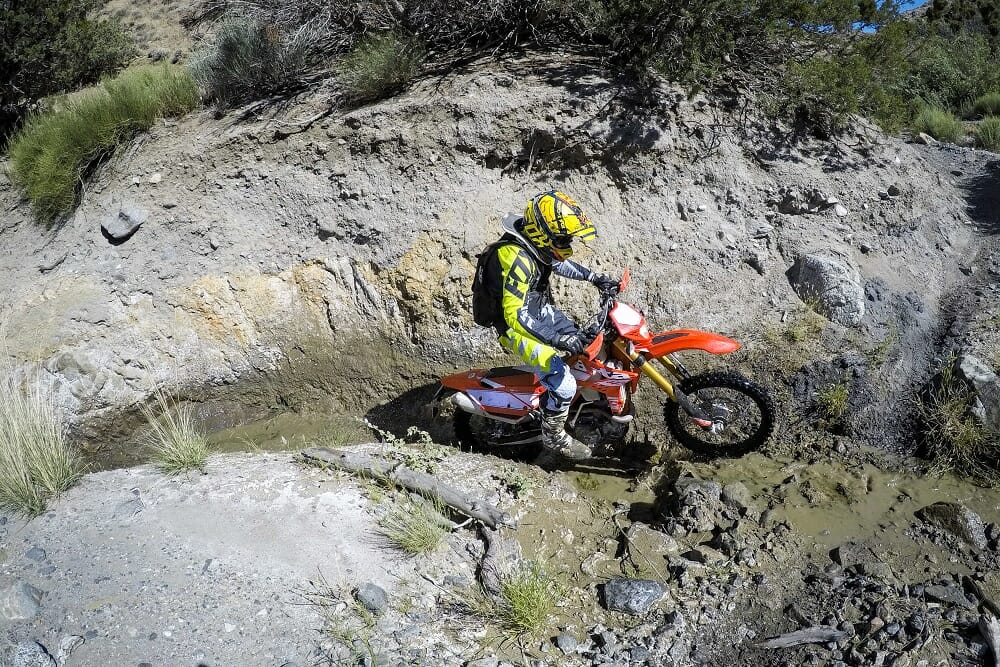 The Beta 390 RR-S is most at home far away from stop lights and pavement.
The Beta 390 RR-S is most at home far away from stop lights and pavement.
The Italian manufacturer Beta offers multiple displacements of dual sport RR-S models to satisfy any type and size of rider. In the past, you could get all the four-stroke displacements in the RR model with only two options for the dual-sport version. Now the four-stroke RR models are RR-S models, which means they are all street legal. The differences between the RR and the dual-sport RS models were so close Beta opted for the license plate on all RR enduro bikes. If you are still looking for a dirt only enduro machine, Beta offers the Race Edition 350, 390, 430 and 480 RR. The Race Edition models are not street legal and designed for the serious off-road racer or the causal rider looking for a more aggressive bike than what the RR-S offers.
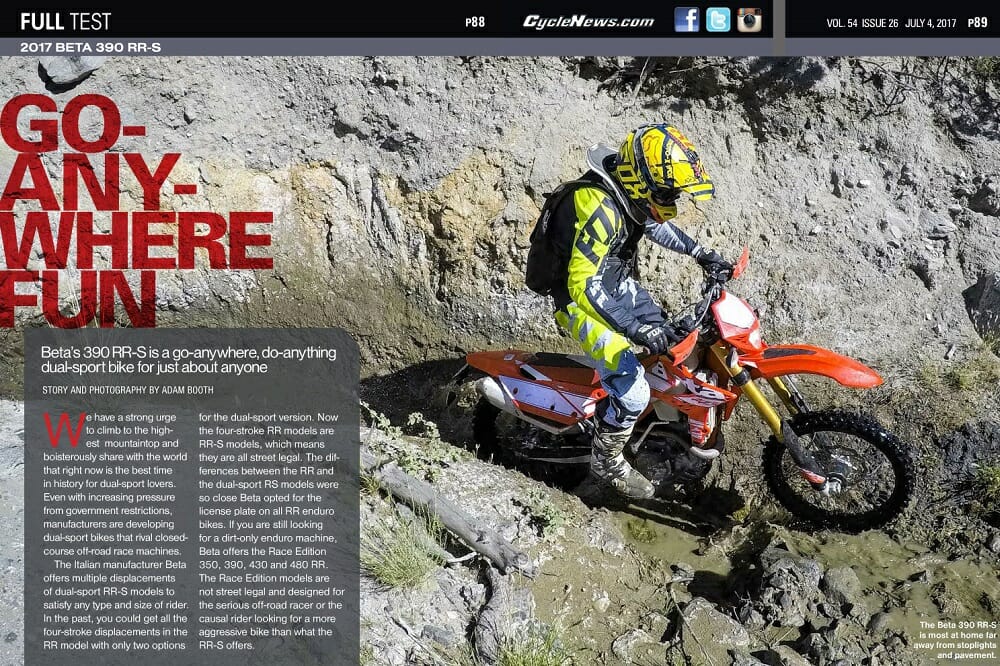
Click here to read this in the Cycle News Digital Edition Magazine.
Photography by Adam Booth
Through the years we’ve always been fans of the 400cc displacement off-road bike. It offers a great blend of torque and high-revving excitement, plus they have a much lighter feeling out on the trail than a 500. The Beta 390 RR-S is pretty darn close to a 400, boasting 386cc’s of displacement. With a lot of long rides planned, Beta delivered the 2017 390 RR-S with a larger IMS gas tank, replacing the stock two-gallon tank. This plated enduro bike has been with us for over two months and we’ve logged over 500 miles off-road, exactly where the modern dual-sport likes to live.
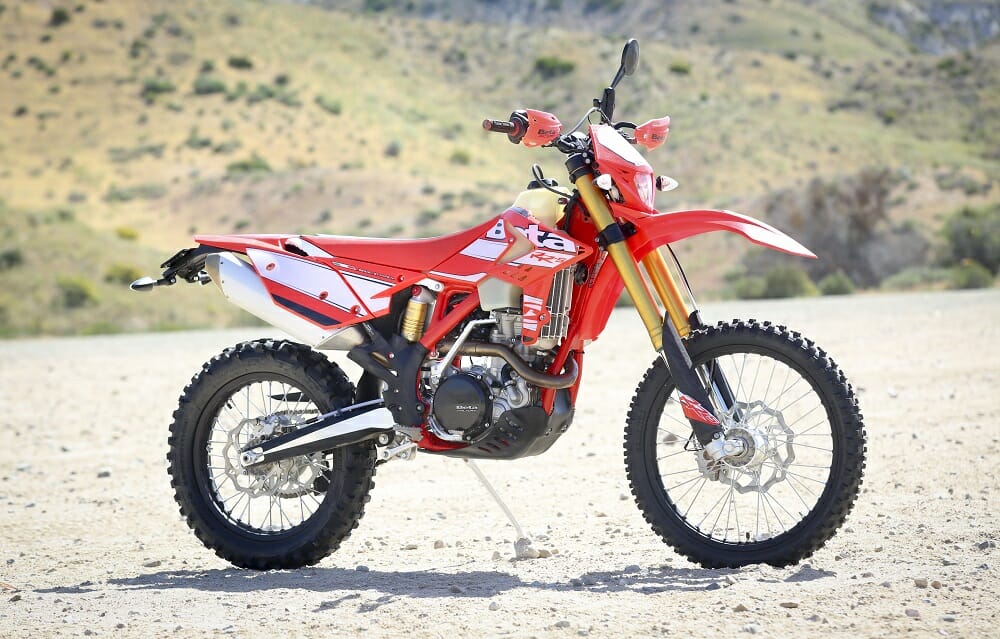 The 390 RR-S is another bike in the fast-growing segment of truly barley street-legal dual sport motorcycles.
The 390 RR-S is another bike in the fast-growing segment of truly barley street-legal dual sport motorcycles.
It’s All About The Dirt
The Beta 390 RR-S might have turn signals and a license plate perched off the rear fender, but these are simply logistic additions to a very capable off-road enduro machine. This is essentially the 390 RR of old, but now it street legal!
A bigger battery for 2017 spins the electric start quickly and the fuel-injected four-stroke Beta 390 engine fires easily. This engine is incredibly easy to ride with power that rolls on smoothly with plenty of torque off idle. The strong low-end power builds predictably into a lively midrange and a decent top-end. The 390 RR-S engine uses the same bore as the 350 RR-S, but uses a longer stroke to achieve 386cc of displacement. This longer stroke doesn’t allow the 390 to rev out quite as far and fast as the 350, instead it provides more torque and traction. The 390 RR-S never coughs or sputters down near idle when under a load, providing great traction in all conditions.
Helping to find traction and control the engine’s ultra smooth power is a Brembo hydraulic clutch. The feel from the Brembo clutch is consistent no matter how much abuse you throw at it, and if you are an aggressive rider, you’ll use the clutch to snap the 390 to life when you need a burst of power.
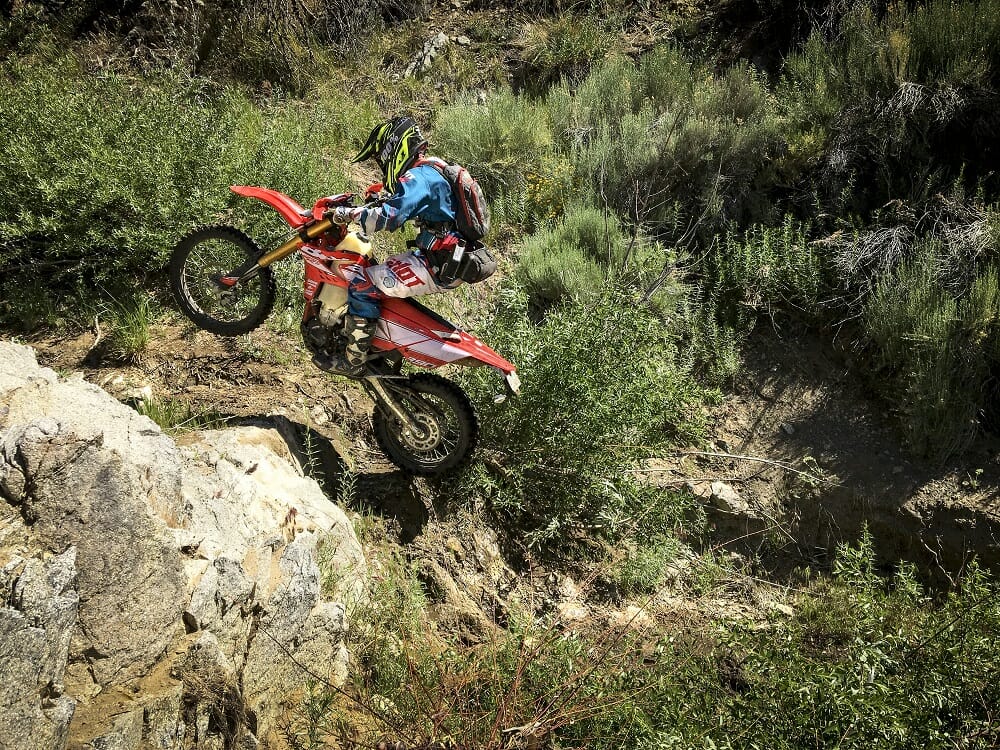 Power is strong but far from intimidating, making the midsized 390 easy to ride.
Power is strong but far from intimidating, making the midsized 390 easy to ride.
The 390 RR-S isn’t slow, in fact it produces a surprising amount of power, but does it in a predictable and friendly way, which some perceive as slow. It is a bit cliché to say the Beta 390 suits a wide range of riding styles, but it is true. If you are a big-displacement engine lover and have always loved a 500cc dual-sport, the 390 will probably be a little disappointing when it comes to raw horsepower numbers, especially when climbing sandy uphills or buzzing down the freeway. As the displacement suggests, a 390 is a great balance between a 250 and big 500 with just enough extra displacement to provide a big boost in torque over a 350. Where most riders fall in love with the power delivery of the 390 RR-S is in true off-road riding terrain, like single track and technical slower riding.
The six-speed wide ratio transmission suits the power of the engine nicely and we learned quickly to use first gear in slow terrain; the 390 just doesn’t have enough torque to pull second gear unless you have a little momentum. Heavier riders may even choose to add a couple teeth to the rear sprocket for a little more grunt and tighter spacing between gears.
The Beta’s powerplant features separate oil compartments for engine and transmission oil, helping to keep transmission grime out of the engine. It adds a little more work when it comes to oil changes, but the benefits are worth it.
Beta equips a kick-starter as a backup if the starter should have an issue, but as with all modern fuel-injected bikes, a super-dead battery will prevent starting even with a kick-starter. We recently learned that the 2018 model will not have a kick-starter and that the cases are the same as the 2017 model, allowing you to install one if you feel the need. We carry mini jumper cables in case of a low battery in these modern fuel-injected times.
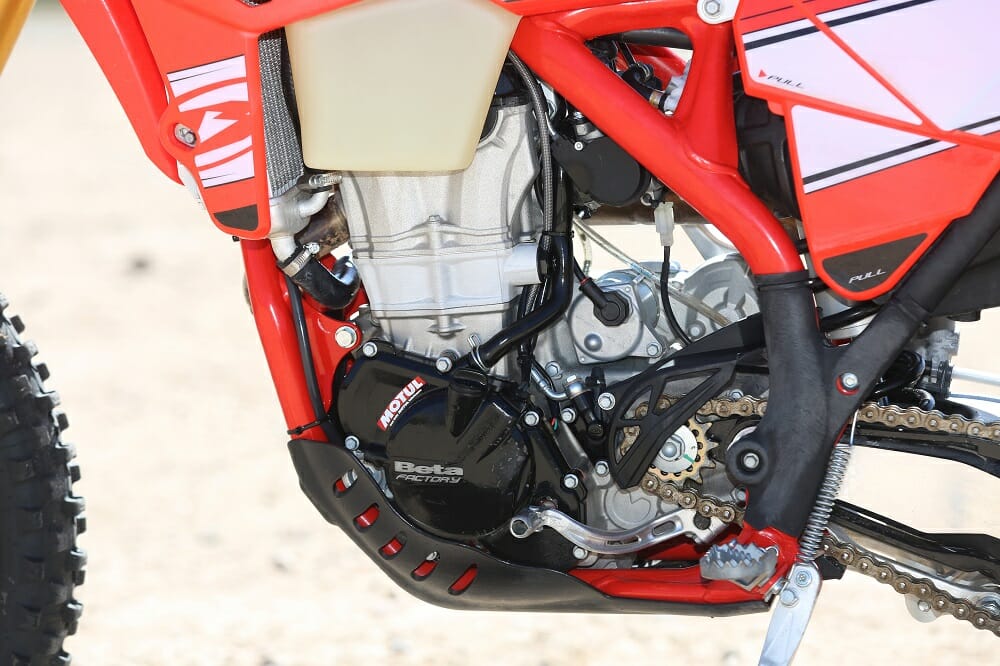 We’ve tested many four-stroke off-road and dual sport Betas in recent years, and their engines have proven to be very reliable.
We’ve tested many four-stroke off-road and dual sport Betas in recent years, and their engines have proven to be very reliable.
Plush Is The New Black
Sachs suspension has been the norm for Beta off-road bikes for quite a few years and every year they improve the performance. The Gen4 Sachs open cartridge fork is much improved even when compared to just a couple of years ago.
Overall balance on the 390 RR-S is great and the best way to describe the feel is to call it incredibly plush. The fork and shock are set up to eat up rocks and roots and square-edge bumps. The Sachs fork requires a solid four hours of break in before its true performance is revealed. Through creek beds and over rough technical terrain the 390 RR-S stays straight and planted, providing great rear-wheel traction, making it easy to climb and navigate tough uphills. Bottoming resistance is pretty good considering the plush overall ride. Remember, the RR-S line is essentially the old RR line of off-road trail bikes, which means they are designed for trail riding, not hammering whoops in fourth gear. When we got a little over confident and going too fast through terrain with g-outs, the rubber suspension stoppers and the rear tire rubbing the underside of the fender told us to back it down a notch. On occasion the front end would dive on step downhills under braking so we increased the compression, which helped without taking away the comfort in normal riding situations. Depending on the area you ride, you may decide to go up a spring rate in the front to reduce the diving.
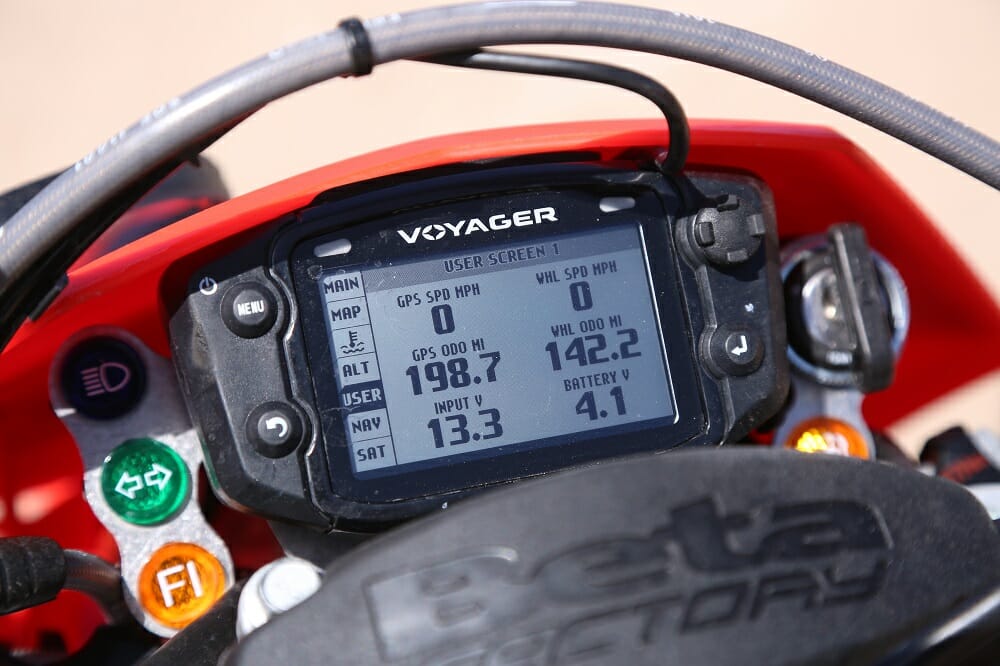 Nice! We love the Beta’s Voyager info unit, which includes full GPS.
Nice! We love the Beta’s Voyager info unit, which includes full GPS.
Also the Beta has a very planted front-wheel feel and the chassis provides a stable ride. The Beta turns nicely but is in no way twitchy feeling when compared to other enduro bikes. The Michelin enduro tires work great in hard terrain, through rocks and in perfect loamy dirt. They suffer when the dirt is loose or sandy—the knobs are just too short and too far spaced, especially on the rear, for these situations. The first thing we do with any long-term off-road test bike is to ditch the stock inner tubes and replace them with super heavy-duty tubes. This allows us to run lower air pressure and maximize traction. We ran the stock tires until they were worn out and went with bigger knobs to help in the sandier dirt.
Again, the combo of the engine, suspension and chassis makes the Beta 390 RR-S incredibly easy and comfortable to ride. The Nissin brakes are incredible on the Betas, so strong, in fact, that a few testers complained that the front bordered on too grabby when navigating steep and technical down hills. Those complaints we’ll blame on operator error. The rear brake pads are nearly gone after 500 miles so we’ll be changing those shortly.
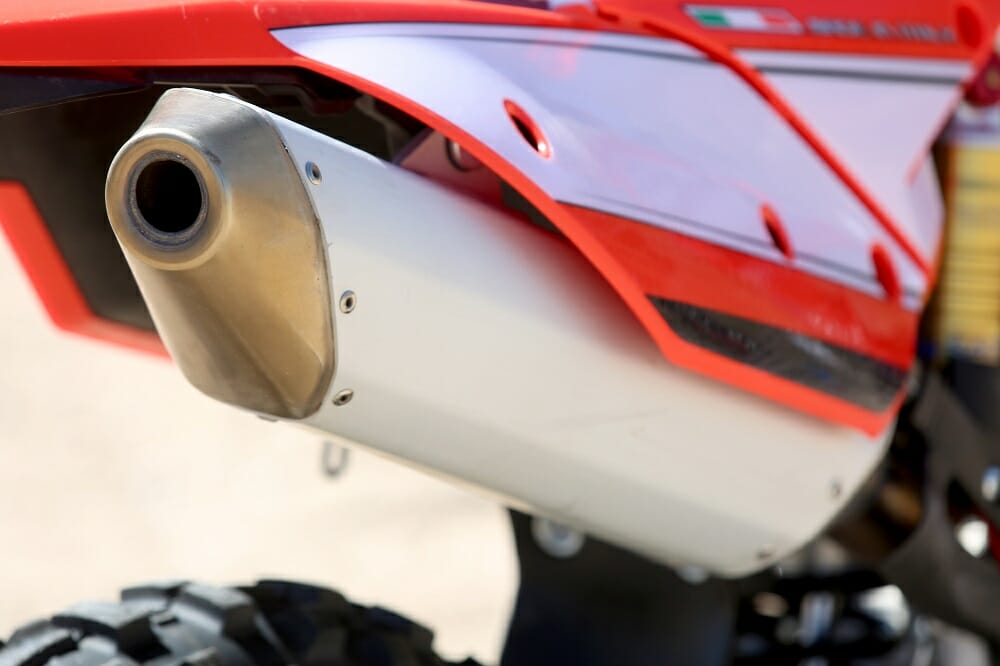 No need to replace the stock muffler—it quiet, looks decent and will keep park rangers happy.
No need to replace the stock muffler—it quiet, looks decent and will keep park rangers happy.
Dual-Sport Heaven
We’ve put the 390 RR-S through some serious off-road romping during the past few months, including big hillclimbs at wide open throttle for nearly a minute and a time and it didn’t complain. The auxiliary cooling fan helps keep engine temps from getting out of control, helping to increase the life of the engine. We had a hot day of slow riding that even the fan couldn’t keep up and the Beta boiled some fluid out of the radiators, requiring some additional coolant, but other bikes on the ride boiled a bit as well.
Thank you Beta for providing a great skid plate, we’ve used it a lot and it’s done an excellent job protecting the frame.
The ergos of the 390 RR-S fit a wide variety of riders and the handlebar position is very adjustable. Riders with big feet praised the rear brake pedal and shifter position while riders with size nine boots complained that the position was a bit farther from the footpeg than normal. It’s a minor difference from other manufactures and only takes a short time to acclimate.
It is pretty cool that Beta equips all the RR-S models with a Voyager Trail Tech info unit. It provides full GPS, maps, engine temp, outside temp, trip meter, rpm, speed, altitude and more. The stator puts out an impressive 200 watts, which means you can power big lights if you like to ride at night.
The push-button seat release and easy-access air filter are awesome highlights, as is the provided tool kit hidden behind the side panel.
To be honest, we didn’t spend a lot of time on the pavement with the Beta 390 RR-S; we just didn’t really have a desire to buzz down the asphalt on such a dirt-worthy bike, and, besides, that’s not what this bike is really about. It’s a full-on dirt bike with a plate. But, if you have to, it will cruise just fine between 55-65 mph, especially if you balance the tires. The bike, of course, rips down dirt roads.
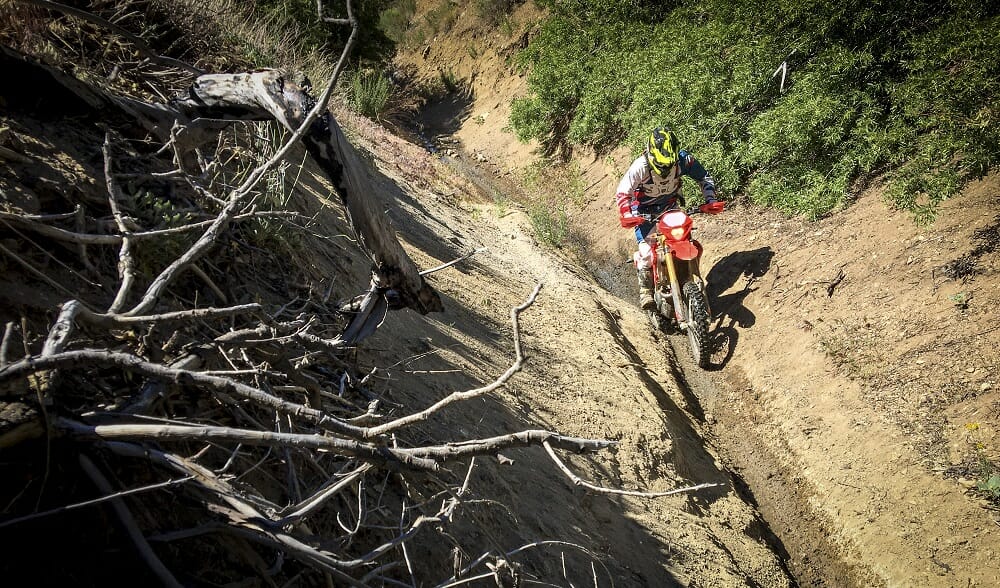 If 390cc isn’t enough for you, Beta offers a 430 and 500.
If 390cc isn’t enough for you, Beta offers a 430 and 500.
If you are part of the ever-increasing group of riders looking for a new off-road capable dual-sport, take a long hard look at the Beta RR-S line. Even if a 390 doesn’t excite you, Beta has a range of displacements that should fit your needs.
As we were finishing our testing time with the 2017 390 RR-S Beta released info on their 2018 models. Some of the changes include a new clutch for less drag and better feel, a new frame with revised flex characteristics and improved turn signals. We are also happy to report that Beta tells us the 2018 Beta 390 RR-S is 8.7 pounds lighter. We are excited that Beta has made improvements on what we consider a great dual-sport bike and look forward to spending some time on the 2018 Beta RR-S models as fall approaches. CN

|
SPECIFICATIONS: 2017 Beta 390 RR-S ($9799)
|
|
ENGINE:
|
Liquid Cooled, SOHC, 4-stroke, single
|
|
DISPLACEMENT:
|
386cc
|
|
BORE X STROKE:
|
88.0 x 63.4mm
|
|
COMPRESSION RATIO:
|
12.5:1
|
|
FUEL DELIVERY:
|
42mm EFI
|
|
LUBRICATION:
|
Twin oil pumps with cartridge oil filter;
separate oil engine/clutch
|
|
STARTING SYSTEM:
|
Electric
|
|
TRANSMISSION:
|
6-speed wide-ratio
|
|
FINAL GEARING:
|
15/50
|
|
FRAME:
|
Steel
|
|
FRONT SUSPENSION:
|
Sachs 48mm telescopic fork, fully adjustable
|
|
REAR SUSPENSION:
|
Sachs shock, fully adjustable
|
|
FRONT WHEEL TRAVEL:
|
11.4 in.
|
|
REAR WHEEL TRAVEL:
|
11.4 in.
|
|
FRONT BRAKE:
|
260mm Disc
|
|
REAR BRAKE:
|
240mm Disc
|
|
FRONT RIM:
|
21×1.60 in.
|
|
REAR RIM:
|
18×2.15 in.
|
|
FRONT TIRE:
|
90/90-21 in. Michelin Enduro (DOT)
|
|
REAR TIRE:
|
110/100-18 in. Michelin Enduro (DOT)
|
|
RAKE:
|
26.5°
|
|
OFFSET: 23mm
|
23mm
|
|
GROUND CLEARANCE:
|
12.6 in.
|
|
SEAT HEIGHT:
|
36.8 in.
|
|
WHEELBASE:
|
58.7 in.
|
|
FUEL CAPACITY:
|
2.0 gal.
|
|
WEIGHT (Claimed):
|
244 lbs.
|
|
WARRANTY:
|
12 month limited
|